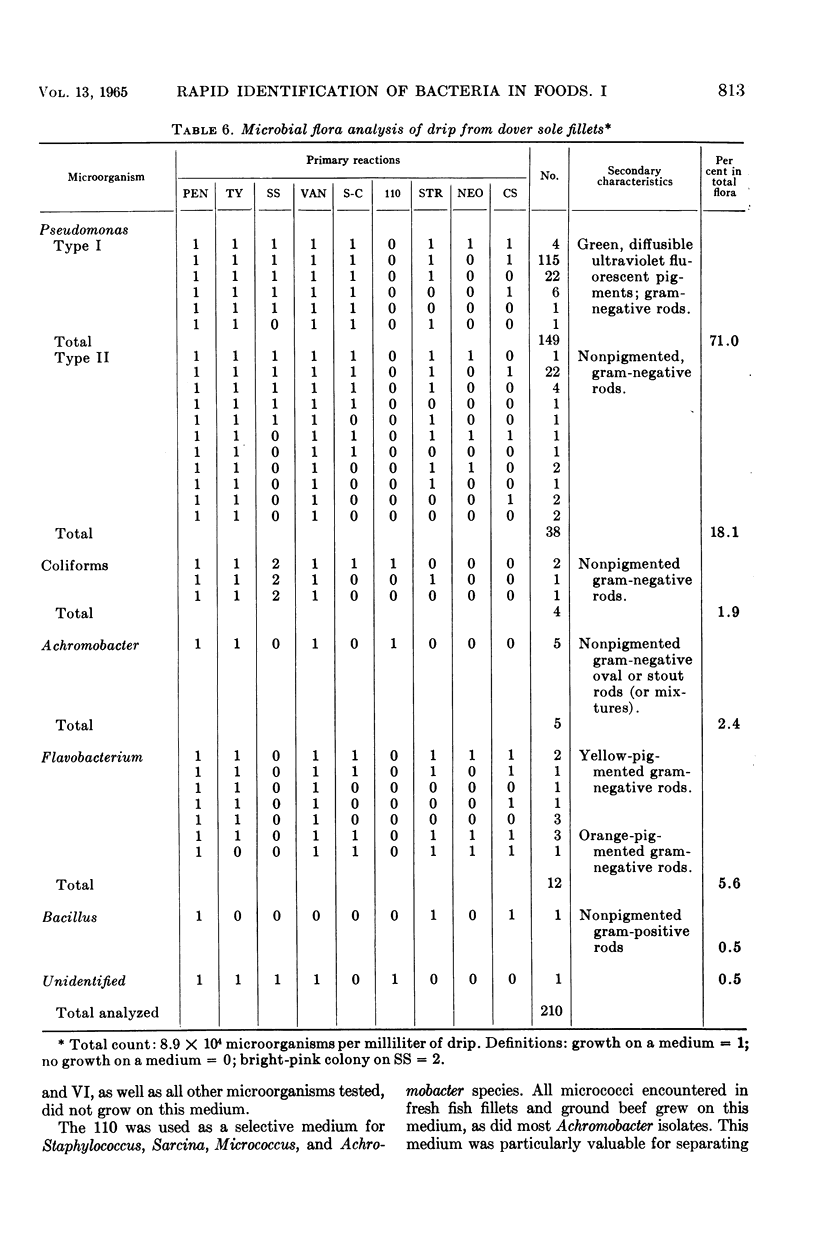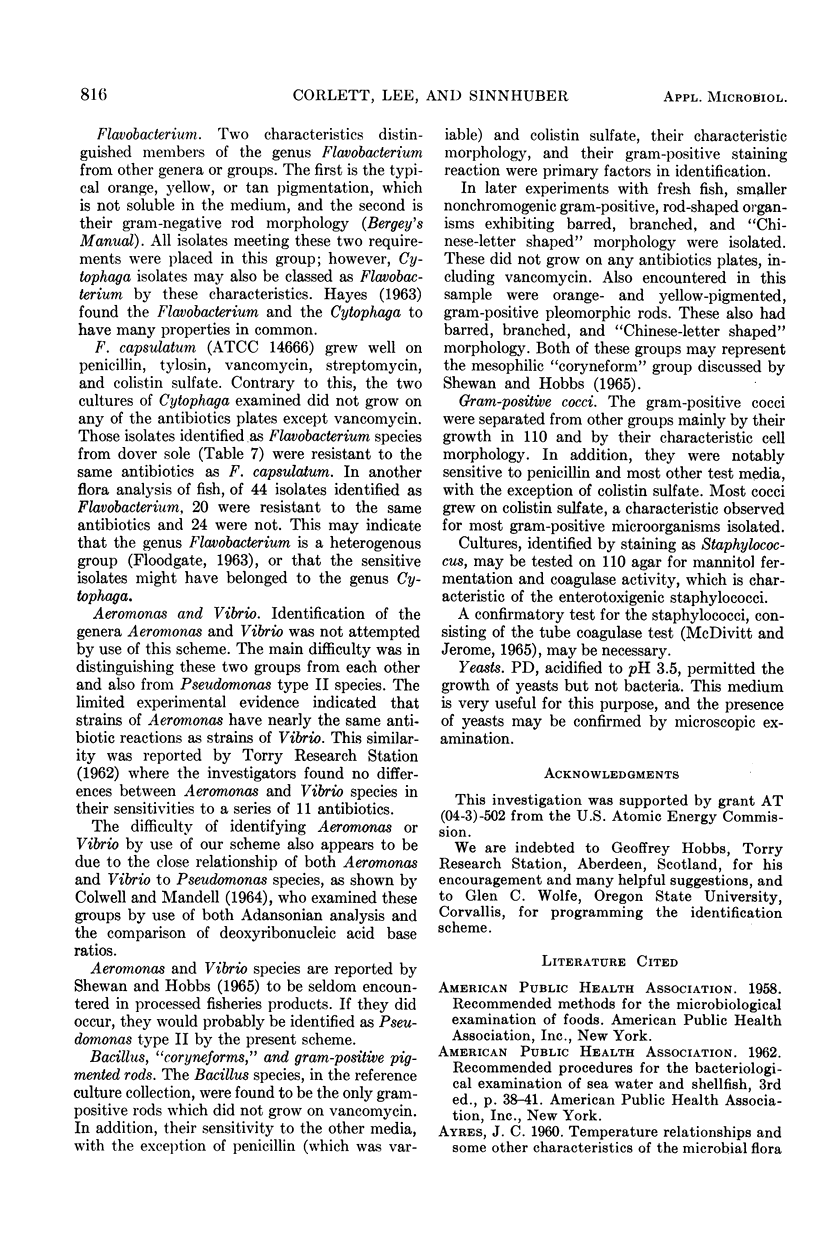Abstract
A method was devised and tested for a quantitative identification of microbial flora in foods. The colonies developing on the initial isolation plates were picked with sterile toothpicks and inoculated on a master plate in prearranged spacing and order. The growth on the master plates was then replicated on a series of solid-agar plates containing differential or selective agents. The characteristic growth and physiological responses of microbial isolates to penicillin, tylosin, vancomycin, streptomycin, chloramphenicol, neomycin, colistin, and to S S Agar, Staphylococcus Medium No. 110, and Potato Dextrose Agar were recorded, together with Gram reaction and cell morphology. This information was then fed into an IBM 1410 digital computer which grouped and analyzed each isolate into 10 microbial genera, or groups, according to the identification key. The identification scheme was established by use of reference culture studies and from the literature. This system was used to analyze the microbial flora in dover sole (Microstomus pacificus) and ground beef. The method described in this article enables one to examine large numbers of microbial isolates with simplicity.
Full text
PDF









Selected References
These references are in PubMed. This may not be the complete list of references from this article.
- COLWELL R. R., MANDEL M. ADANSONIAN ANALYSIS AND DEOXYRIBONUCLEIC ACID BASE COMPOSITION OF SOME GRAM-NEGATIVE BACTERIA. J Bacteriol. 1964 Jun;87:1412–1422. doi: 10.1128/jb.87.6.1412-1422.1964. [DOI] [PMC free article] [PubMed] [Google Scholar]
- FRANK H. A. Influence of low incubation temperature on classification of Pseudomonas geniculata. J Bacteriol. 1962 Jul;84:68–71. doi: 10.1128/jb.84.1.68-71.1962. [DOI] [PMC free article] [PubMed] [Google Scholar]
- HAYES P. R. Studies on marine flavobacteria. J Gen Microbiol. 1963 Jan;30:1–19. doi: 10.1099/00221287-30-1-1. [DOI] [PubMed] [Google Scholar]
- Ingraham J. L., Stokes J. L. PSYCHROPHILIC BACTERIA. Bacteriol Rev. 1959 Sep;23(3):97–108. doi: 10.1128/br.23.3.97-108.1959. [DOI] [PMC free article] [PubMed] [Google Scholar]
- KING E. O., WARD M. K., RANEY D. E. Two simple media for the demonstration of pyocyanin and fluorescin. J Lab Clin Med. 1954 Aug;44(2):301–307. [PubMed] [Google Scholar]
- LEDERBERG J., LEDERBERG E. M. Replica plating and indirect selection of bacterial mutants. J Bacteriol. 1952 Mar;63(3):399–406. doi: 10.1128/jb.63.3.399-406.1952. [DOI] [PMC free article] [PubMed] [Google Scholar]
- MASUROVSKY E. B., VOSS J. S., GOLDBLITH S. A. Changes in the microflora of haddock fillets and shucked soft-shelled clams after irradiation with Co-60 gamma rays and storage at 0 C and 6 C. Appl Microbiol. 1963 May;11:229–234. doi: 10.1128/am.11.3.229-234.1963. [DOI] [PMC free article] [PubMed] [Google Scholar]
- MCDIVITT M. E., JEROME N. W. LIMITATIONS OF FIBRINOGEN-POLYMYXIN MEDIUM IN DETECTING COAGULASE-POSITIVE STAPHYLOCOCCI IN RAW MILK. Appl Microbiol. 1965 Mar;13:157–159. doi: 10.1128/am.13.2.157-159.1965. [DOI] [PMC free article] [PubMed] [Google Scholar]
- SHEWAN J. M., HODGKISS W. A method for the rapid differentiation of certain nonpathogenic, asporogenous bacilli. Nature. 1954 Jan 30;173(4396):208–209. doi: 10.1038/173208b0. [DOI] [PubMed] [Google Scholar]
- SMUCKLER S. A., APPLEMAN M. D. IMPROVED STAPHYLOCOCCUS MEDIUM NO. 110. Appl Microbiol. 1964 Jul;12:355–359. doi: 10.1128/am.12.4.355-359.1964. [DOI] [PMC free article] [PubMed] [Google Scholar]


